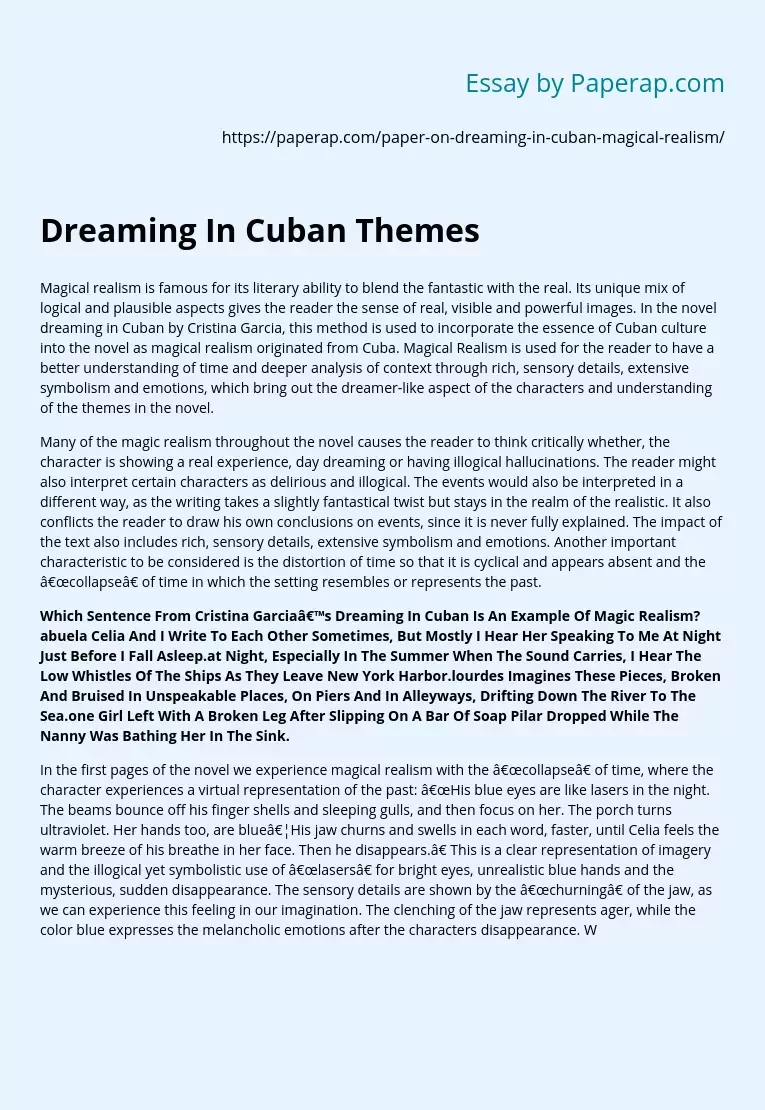Dreaming In Cuban Themes
Magical realism is famous for its literary ability to blend the fantastic with the real. Its unique mix of logical and plausible aspects gives the reader the sense of real, visible and powerful images. In the novel dreaming in Cuban by Cristina Garcia, this method is used to incorporate the essence of Cuban culture into the novel as magical realism originated from Cuba. Magical Realism is used for the reader to have a better understanding of time and deeper analysis of context through rich, sensory details, extensive symbolism and emotions, which bring out the dreamer-like aspect of the characters and understanding of the themes in the novel.
Many of the magic realism throughout the novel causes the reader to think critically whether, the character is showing a real experience, day dreaming or having illogical hallucinations. The reader might also interpret certain characters as delirious and illogical. The events would also be interpreted in a different way, as the writing takes a slightly fantastical twist but stays in the realm of the realistic.
It also conflicts the reader to draw his own conclusions on events, since it is never fully explained. The impact of the text also includes rich, sensory details, extensive symbolism and emotions. Another important characteristic to be considered is the distortion of time so that it is cyclical and appears absent and the “collapse” of time in which the setting resembles or represents the past.
Which Sentence From Cristina Garcia’s Dreaming In Cuban Is An Example Of Magic Realism?abuela Celia And I Write To Each Other Sometimes, But Mostly I Hear Her Speaking To Me At Night Just Before I Fall Asleep.
at Night, Especially In The Summer When The Sound Carries, I Hear The Low Whistles Of The Ships As They Leave New York Harbor.lourdes Imagines These Pieces, Broken And Bruised In Unspeakable Places, On Piers And In Alleyways, Drifting Down The River To The Sea.one Girl Left With A Broken Leg After Slipping On A Bar Of Soap Pilar Dropped While The Nanny Was Bathing Her In The Sink.
In the first pages of the novel we experience magical realism with the “collapse” of time, where the character experiences a virtual representation of the past: “His blue eyes are like lasers in the night. The beams bounce off his finger shells and sleeping gulls, and then focus on her. The porch turns ultraviolet. Her hands too, are blue…His jaw churns and swells in each word, faster, until Celia feels the warm breeze of his breathe in her face. Then he disappears.” This is a clear representation of imagery and the illogical yet symbolistic use of “lasers” for bright eyes, unrealistic blue hands and the mysterious, sudden disappearance. The sensory details are shown by the “churning” of the jaw, as we can experience this feeling in our imagination. The clenching of the jaw represents ager, while the color blue expresses the melancholic emotions after the characters disappearance. We connect this magical realism to the theme of memory and love. Celia’s love for her husband, who is no longer alive, is evident as she can remember his features and movements so clearly.
Celia’s daughter, Lourdes also has a similar encounter with the hallucination of her father, who is no longer alive: “Four blocks from her home, Lourdes smells her fathers cigar…she pictures them slipping from their sockets and moving before her in a steady gait…Cautiously she follows them.” In this example of magical realism the olfactory sense of the cigar is used to describe her intense emotions towards her father. Her emotions are clearly represented by the word “she cautiously follows”, as this suggests that Lourdes is nostalgic of the memory of her father and also, afraid that this is just a creation of her mind instead of reality. Other sensory details include the “slipping from their sockets” as we have a clear, detailed, visual representation of the characters motions.
Lourdes links the smell with the past, as Garcia represents the cigar as a symbol that reminds Lourdes of her father. This results in the yearning for this memory and creation of a hallucination that suggests her father is still alive. In this magical realism we can connect this passage with the theme of family, which plays an important role in the novel. Lourdes is very emotionally attached to her father since she was a little girl, yet is conflicted with her mother. This also shows the affects of physical separation in the novel, due to politics in Cuba, as her father had lived in the United States with his daughter while Celia remained in Cuba.
Christina Garcia elaborates the novels themes and better understanding of the characters by showing the reader direct images or thoughts from their minds of all the main characters. Although, people never reveal it, most people have personal magical realism instances that directly show our deepest wishes and concerns. The portrayal of magical realism makes the difference by the significance of analyzing these “daydreams” with the novels themes, symbolism and imagery.
Dreaming In Cuban Themes. (2019, Dec 05). Retrieved from https://paperap.com/paper-on-dreaming-in-cuban-magical-realism/

